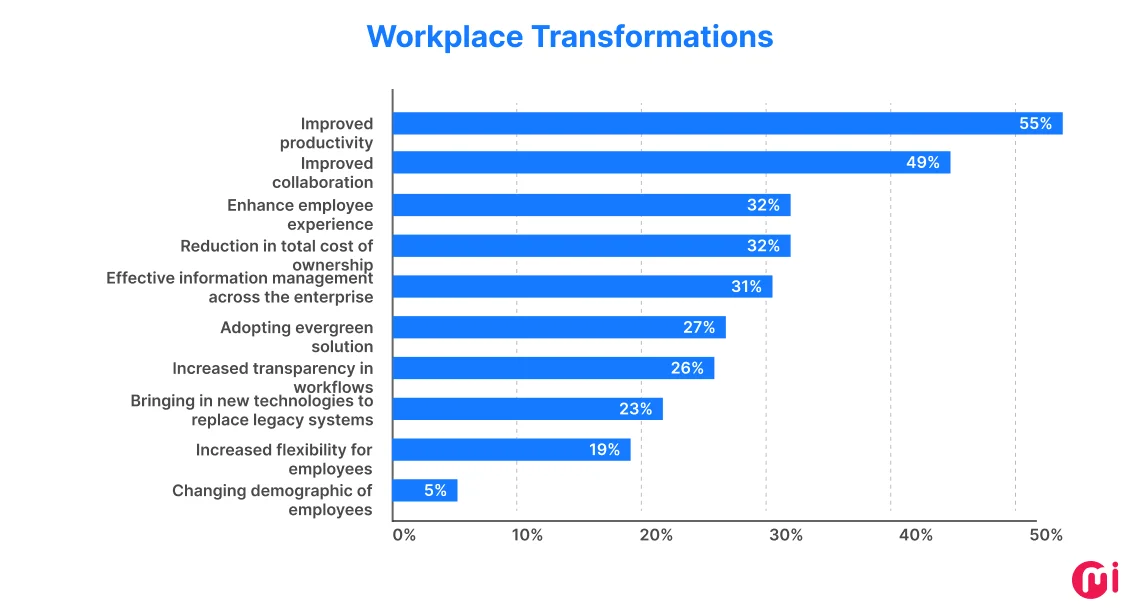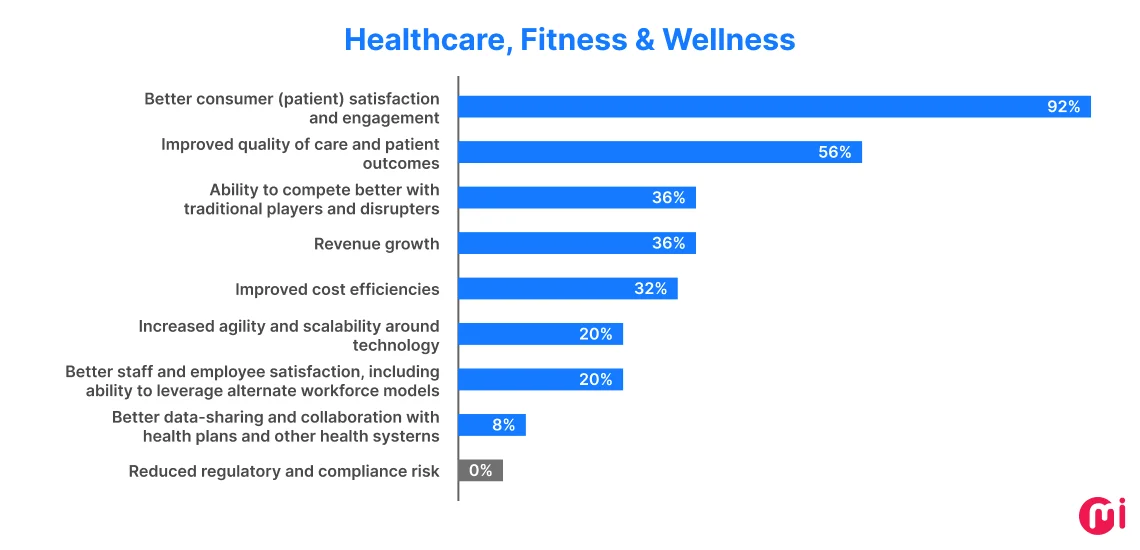Digital transformation requires more than just adopting new technologies—it requires data-backed strategies to drive cultural shifts, enhance operational efficiency, and deliver long-term value to customers and employees alike. This is where digital transformation statistics play a critical role, offering insights that support these strategies and guide decision-making for sustained success. Read this blog to explore statistics on digital transformation that back your strategic decision-making process and business decisions.
67% of business leaders believe that their company will lose its competitive edge if it fails to become more digital.
This has led most organizations to engage in some or the other forms of digital initiatives targeting different aspects of their business, whether it be operational efficiency, customer management, or other areas.
However, businesses often look for numbers to answer questions such as:
- How many organizations are adopting a digital-first approach?
- What is the contribution of various next-generation technologies to digital transformation?
- What are the data insights on digital transformation in my industry?
And so on.
The goal is to find answers that put the uncertainties of digital transformation at ease.
This is where the power of statistical insights comes in.
Understanding the nuances of digital transformation through data-driven insights empowers decision-makers to make informed, strategic choices. Armed with the right knowledge, they can navigate the complexities that come in the way of achieving intended transformation goals and move a step closer to success.
Read on to discover actionable statistics on digital transformation and equip your organization with the knowledge to lead it toward a digital-first future.


Digital Transformation Statistics: An Overview of the Market
With 74% of organizations having digital transformation as their priority, the business landscape is rapidly shifting towards digital. Here is further evidence, supported by a current market overview of digital transformation:
- Last year, global spending reached an impressive $2.15 trillion, and it is expected to nearly double to $3.9 trillion by 2027, indicating a robust growth trajectory for the market.
- The global digital transformation market is anticipated to grow at a compound annual growth rate (CAGR) of 25% from 2024 to 2033
- Regionally, North America is expected to dominate the digital transformation market, with a projection to hold 24.3% of the global market share by 2034.
- Meanwhile, the East Asian digital transformation market is also gaining traction, with an estimated market size of $177.8 billion for 2024.
- Overall, the digital transformation market, valued at $911.2 billion in 2024, is expected to grow significantly, reaching approximately $3.29 trillion by 2030. This represents an impressive annual growth rate of 23.9% during the forecast period from 2024 to 2030.
A Statistical Perspective of Trends in Digital Adoption
Owing to digital transformation, organizations are embracing change through digital adoption in various aspects of their business processes. The statistics below underscore the importance of embracing a digital-first strategy:
- 93% of organizations have already adopted or plan to adopt such strategies.
- A staggering 87% of companies acknowledge that digital technologies will disrupt their industry; however, only half of these organizations feel adequately prepared for the impending changes.
- Digitally transformed entities are even significantly driving economic growth, contributing to 50% of the global GDP.
- By 2025, it is projected that an additional $100 trillion in value will be generated for the world economy as a direct result of digital transformation efforts.
Business Process Transformation: A Statistical Breakdown
As a core component and an enabler of the broader digital transformation framework, business process transformation enables decision-makers to enhance operational efficiency, improve customer relations, and drive profitability.
Here are data-backed insights into various aspects that collectively contribute to business process transformation:
Emerging Technologies Driving Digital Transformation
A substantial 80% of executives firmly believe that data-driven disruptive technologies will transform the competitive landscape. As organizations adopt these innovations, they are increasingly investing in next-generation technologies to enhance operational efficiency and optimize processes.
- As we move forward, automation is gaining traction, with 53% of organizations already on their Robotic Process Automation (RPA) journey, the figure expected to rise to 72% within the next two years.
- The market for artificial intelligence (AI) is experiencing remarkable growth, surpassing $184 billion in 2024, with projections indicating it could exceed $826 billion by 2030.
- 26% of organizations are considering AI and machine learning technologies, while 24% are piloting implementations.
- 60% of organizations are integrating generative AI into their marketing efforts, underscoring its transformative potential in reshaping workflows and enhancing decision-making.
- Gartner analysts predict that over 85% of organizations will adopt a cloud-first approach by 2025.
- Cloud computing, as of now, holds the tag for the highest adoption rate among emerging technologies as 90% of organizations worldwide have implemented cloud technologies.
- As of last year, nearly 92% of digital leaders reported that their companies have adopted cloud technology on either a small or large scale.
- Big data and analytics were the second most widely adopted technologies, with around 61% of respondents indicating usage.
Workplace Transformations
Modern workplaces feel different—streamlined with no collaboration silos, enhanced task automation, increased efficiency, improved employee engagement, and more.
Workplace transformation delivers tangible results, including a 55% boost in productivity, a 49% improvement in collaboration, a 32% increase in employee engagement, and a 32% reduction in total cost of ownership, among other benefits.


The impact is so substantial that a significant majority (57%) of surveyed organizations recognize that digital transformation elements have the most considerable effect on workplace transformation, surpassing the influence of physical (38%) and cultural (15%) transformation elements.
- Apart from technology adoption, on-premise solutions hold a commanding share of over 63.9%, favored for their customization benefits and data security.
- An impressive 86% of CXOs believe that enhanced collaboration across teams is a significant advantage of workplace transformation.
- Additionally, workplace transformations lead to higher levels of employee productivity (84%) and an improved employee experience (83%).
Workforce Transformation
A workforce equipped with the right skills and culture can contribute to driving sustained business success. It is also one of the underlying, or rather, fundamental requirements for the success of enterprise digital transformation.
Here are the data-driven insights suggesting how companies are constantly working on workforce transformation, whether on a small or large scale:
- Companies today are investing heavily on employee training and development, with spending exceeding $340 billion annually. On average, organizations allocate more than $1,500 per employee each year.
- According to a survey, 86% of CXOs believe that workplace transformation significantly enhances collaboration across teams.
- According to the International Data Corporation (IDC), by 2023, 60% of Global 2000 companies are expected to transform the entire employee life cycle—from onboarding to retirement—by leveraging artificial intelligence (AI) and machine learning (ML) powered platforms.
Customer Relationship Transformation
As these business process transformations are interconnected in terms of the overall impact they have, CXOs recognize that workplace transformation is vital for delivering superior customer experiences. Here is how digital transformation can empower you to control the perception your customers have of your brand:
- A recent study shows that 84% of CXOs believe that enhancing the workplace can significantly improve how customers perceive and interact with their brands.
- Currently, around 65% of tasks and 50-70% of customer interactions are automated, creating a true omnichannel experience. This seamless integration across various platforms allows companies to provide a consistent and cohesive experience for their customers, regardless of how they choose to engage with the brand.
- Moreover, the shift towards a digital-first approach is gaining momentum, with 44% of companies already implementing this strategy to enhance operations and customer engagement.
- Investing in customer experience is not merely an operational upgrade; it is a strategic financial decision. Companies that generate $1 billion annually can potentially earn an additional $700 million over three years by prioritizing customer experience initiatives.
- Furthermore, digital transformation focused on customer experience has shown promising results, leading to a 20-30% increase in customer satisfaction and economic gains ranging from 20-50%.
Digital Finance Transformation
Finance, being one of the critical aspects of a streamlined business process, highlights where companies stand in terms of digital finance transformation:
- Recent statistics reveal that over 80% of CFOs at large companies are currently engaged in or planning for significant digital finance transformation initiatives.
- 79% of CFOs prioritize leading these transformation efforts as critical to their organizations’ success.


Digital Transformation Statistics: Key Insights Across Industries
Recently, the digital transformation landscape has been significantly shaped by the increasing demand for innovative digital transformation solutions. So much so that these business solutions have emerged as the dominant force in the market, capturing an impressive 69.7% market share. This surge reflects the growing recognition across various industries of the critical need to adopt people-centric digital initiatives.
Among the sectors leading the charge in digital-first strategies, services rank highest, with a staggering 95% of organizations embracing digital transformation. This is closely followed by financial services at 93% and healthcare at 92%.
Here are key insights on digital transformation across industries:
Healthcare, Fitness & Wellness
In the post-pandemic era, digital transformation has taken center stage across various industries, particularly in healthcare, fitness, and wellness. This shift reflects a broader acceptance of digital solutions in healthcare, which are transforming the way patients interact with providers.
A significant trend is that over 40% of patients have expressed a desire to continue utilizing telehealth services even post-pandemic.
Here is an overview of what healthcare businesses can expect from digital transformation initiatives:
- 92% increase in patient satisfaction and engagement
- 56% improvement in the quality of patient care and outcomes
- 36% greater ability to compete with traditional players and disruptors
- 35% revenue growth


In terms of the market overview of digital transformation in healthcare, fitness, and wellness, here is what you need to know:
- The digital transformation market in healthcare is projected to grow dramatically, expanding from USD 219.6 billion in 2023 to USD 1,183.2 billion by 2030. This growth translates to a remarkable CAGR of 32.40% during the forecast period from 2024 to 2032.
- Similarly, the digital fitness and well-being market is experiencing substantial growth, with revenue projected to reach USD 58.64 billion in 2024. This sector is expected to maintain a CAGR of 7.31%, resulting in a projected market volume of USD 83.43 billion by 2029.
- The adoption of eHealth solutions is rapidly increasing, evident from the growing use of electronic medical record (EMR) systems. The global market for EMRs is expected to reach USD 47.2 billion by 2027.


BFSI
Driven by technological advancements and changing consumer expectations, the Banking, Financial Services, and Insurance (BFSI) industry is experiencing a significant transformation. Here are some key insights reflecting the current state and future projections for digital transformation in this sector:
- Global enterprise IT spending in the banking and investment services market is projected to increase by 8.7% in 2024, reaching $735.6 billion in constant U.S. dollars. This growth is expected to continue, with a five-year compound annual growth rate (CAGR) of 9.3%, potentially reaching an estimated $1 trillion by 2028.
- According to the latest Gartner Hype Cycle for Digital Banking Transformation, Banking-as-a-Service (BaaS) is set to achieve mainstream adoption within the next two years. Gartner forecasts that 30% of banks with assets exceeding $1 billion will launch BaaS initiatives to generate new revenue by the end of 2024.
- By 2030, traditional boundaries within the financial services industry are expected to dissolve, leading to a trend known as ‘platformication.’ This shift will enable banks to offer customers the ability to select personalized services from a diverse range of providers, tailored to their specific needs.
- The global Digital Finance Market was valued at USD 3,835.2 million in 2023 and is expected to grow to USD 10,095.7 million by 2031, representing a strong CAGR of 13.05% from 2024 to 2031.
However, digital transformation in banking and financial institutions is multifaceted, making it a challenging endeavor at times. If you are planning for digital transformation for your banking institution, read our blog on digital transformation in banking to understand the driving factors, challenges, benefits, and practical steps.
Real Estate & Construction
Digitalization is laying the foundation for digital transformation in the real estate industry. Here are some valuable insights that will provide you with an overview of digital trends in this industry:
- Recent surveys indicate that a minimum of 60% of real estate companies are allocating between 1% and 5% of their revenue toward digital initiatives.
- Companies that invest in new technologies have reported significant returns, with the implementation of an additional technology linked to a 1.4% increase in revenue growth, a 1% increase in profit growth, and a greater number of projects completed on time and within budget.
- 62% of purchasers leverage digital tools when making real estate deals. This figure is projected to rise to an impressive 90% by 2030 and potentially reach 100% in some countries, largely driven by the active market participation of Millennials and Generation Z.
- According to Oxford researchers, over half (53%) of real estate companies have started investing in technology in the past few years. This has led to major benefits for their operations.
- According to third-party research conducted by Foundry, only 40% of architecture, engineering, and construction (AEC) firms are utilizing automated workflows for their complex projects.
Transport & Logistics
To rapidly thrive in a changing marketplace, transport and logistics companies are prioritizing technological innovation. Here are insights into digital transformation in this industry:
- As mentioned in the findings from S&P Global Market Intelligence’s Supply Chain Digital Transformation Enterprise Survey 2023, 67% of shipping and logistics firms report that they have implemented a formal strategy to digitize their business processes.
- Cloud computing emerges as the most impactful, with 40% of shipping and logistics firms identifying it as a critical enabler of their digital transformation efforts.
- The global digital logistics market is poised for remarkable growth, with its size valued at USD 32.44 billion in 2024. Projections indicate a rise to USD 120.33 billion by 2032, representing a CAGR of 17.8% during the forecast period.
- Spending on digital transformation within the logistics market is also on the rise. Valued at USD 57.2 billion in 2023, this market is expected to grow at a CAGR of 9.35% during the forecast period from 2024 to 2030, reaching USD 106.95 billion.
- 20% of the surveyed companies have significantly enhanced their digital capabilities by investing 2.5 times more of their IT budgets in innovation compared to their less digitally mature counterparts.
Travel & Hospitality
According to a recent survey by HotelTechReport, 81% of hoteliers believe that technology will be crucial for their business’s success in the next five years. This sentiment highlights the industry’s growing recognition of the role that digital solutions play in enhancing operations and customer experiences.
Here are some statistics on digital transformation in the travel and hospitality industry:
- The World Economic Forum’s Digital Transformation Initiative (DTI), underscores the importance of digitalization, projecting that from 2016 to 2025, advancements in the aviation, travel, and tourism sectors could create up to US$305 billion in value. This shift is expected to increase profitability, transfer US$100 billion in value from traditional players to new competitors, and create US$700 billion in benefits for customers and society.
- In 2023, the global hospitality market hit an impressive $4.7 trillion and is projected to expand to $5.8 trillion by 2027, reflecting a Compound Annual Growth Rate (CAGR) of 5.5%. A major factor fueling this growth is the widespread implementation of digital transformation strategies.
- 39% of hoteliers recognized “improving operational efficiency” as the primary value proposition of technology. Whereas, 31% cited “transforming guest journeys,” while 15% focused on “enhancing business agility,” and 13% mentioned “innovation for the future.”
Retail & E-commerce
When it comes to embracing technologies and implementing digital initiatives, retail and e-commerce have been at the forefront since the advent of the Internet. Here is a glimpse into the statistics of digital transformation in the retail and e-commerce industry:
- The digital transformation market in the retail industry is expected to experience significant growth, rising from USD 243.57 billion in 2024 to USD 541.44 billion by 2029, representing a compound annual growth rate (CAGR) of 17.32% during this forecast period.
- Worldwide mobile commerce sales are expected to reach $2.07 trillion in 2024, reflecting a 21.1% increase from the $1.71 trillion recorded in 2023.
- Recent research indicates that 91% of retail IT leaders prioritize AI as the most important technology to implement by 2026.
- The global AI market in retail, valued at USD 9.36 billion in 2024, is projected to expand significantly and grow to USD 85.07 billion by 2032, reflecting a remarkable CAGR of 31.8%.
If you are a retail and e-commerce company planning for digital transformation, download this whitepaper on Digital Transformation in Retail to discover the strategies you can consider for omnichannel success.
Education
The integration of digital solutions is not just a trend; it represents a fundamental shift in how higher education institutions operate. As technology continues to advance, the ability to blend traditional teaching methods with innovative digital practices will be crucial for institutions aiming to stay competitive and meet the demands of modern learners.
- By 2028, a remarkable 65% of higher education CIOs will regard enhancing operating margins as the key objective of their digital technology investments, marking a significant rise from only 32% in 2024.
- 63% of European higher education institutions are projected to adopt a hybrid operating model that combines both physical and virtual capabilities
Challenges Companies Face in Digital Transformation: Data-Supported Insights
Digital transformation bears desirable fruits only when done right. This requires navigating challenges, which can be better done by learning from what other C-suite leaders have already experienced. Here are statistics on digital transformation challenges most decision-makers face:
- According to a Gartner study, only 35% of board directors have either achieved or are on track to achieving their digital transformation goals.
- A significant challenge is the skills shortage, with 42% of C-suite leaders citing it as one of the top three obstacles limiting their ability to adapt to change.
- Nearly half of executives (47%) report that they are not fully prepared to manage the accelerating pace of technological advancements.
- A Gartner report reveals that 53% of organizations surveyed have yet to be tested against digital challenges, which raises concerns about their overall readiness for transformation.
- Salesforce reports that 98% of IT organizations encounter challenges with digital transformation, with 80% identifying data silos as a significant issue. Furthermore, 72% of organizations are contending with systems that are excessively interdependent.
- Smaller organizations, especially those with fewer than 100 employees, are 2.7 times more likely to achieve successful digital transformation than large enterprises with more than 50,000 employees.
Apart from these challenges, decision-makers also often struggle to find the right digital transformation partner who can not only provide technical support but also ensure the success of these strategies.
Digital Transformation Statistics: How Businesses are Benefiting
It is the transformative power of these digital initiatives that businesses seek. By easily navigating the challenges and backing your strategy with valuable insights, here are the potential insightful digital transformation benefits:
- 80% of organizations that have completed digital transformations report increased profits
- 84% of executives surveyed agree that new business opportunities are emerging as their organizations digitally transform.
- Organizations that rank in the top 25% of impact distribution are considered to have “higher maturity” in their digital transformation initiatives.
- 47% of CEOs face challenges from their board of directors to make progress in digital business. Interestingly, 56% of these CEOs report that their digital improvements have already led to increased profits.
- Studies show that enhancements in operations and IT can lead to a 20% to 30% increase in customer satisfaction, as well as a 10% to 20% rise in employee satisfaction. These improvements can subsequently yield economic benefits of 20% to 50% of the cost base impacted during the transformation process.
- A study of over 4,000 global organizations reveals that digital transformation initiatives can enhance enterprise value.
There are also numerous digital transformation examples across industries that you can consider to understand the digital transformation strategies they have adopted and how they have capitalized on the benefits of these strategies.
Wrap Up
Regardless of the industry or business size, digital transformation has become a critical agenda. With continuous disruption and digital technology taking center stage, C-suite executives have realized that it is the fabric for enterprise survival. Businesses must make strategic digital investments, leveraging new technologies, mobilizing organizations, adopting new mindsets, and more to increase their odds of success. Data-driven insights, like those mentioned above, can significantly ease the journey for these decision-makers.
FAQs on Digital Transformation
These three terms are often misunderstood despite their distinct meanings. Digitization refers to converting physical information into digital formats, such as scanning documents, without changing processes. Digitalization involves using digital tools to enhance and automate existing workflows, improving efficiency but not altering the business model. Digital transformation is a broader, strategic shift, leveraging technology to revamp business operations, models, and customer interactions completely.
Apart from common reasons like low employee engagement, poor cross-functional collaboration, weak management support, and lack of accountability, sustaining digital transformation also needs a major shift in mindsets and behaviors, which many leaders find difficult. Together, these challenges cause most digital transformations to fail.













Leave a Reply